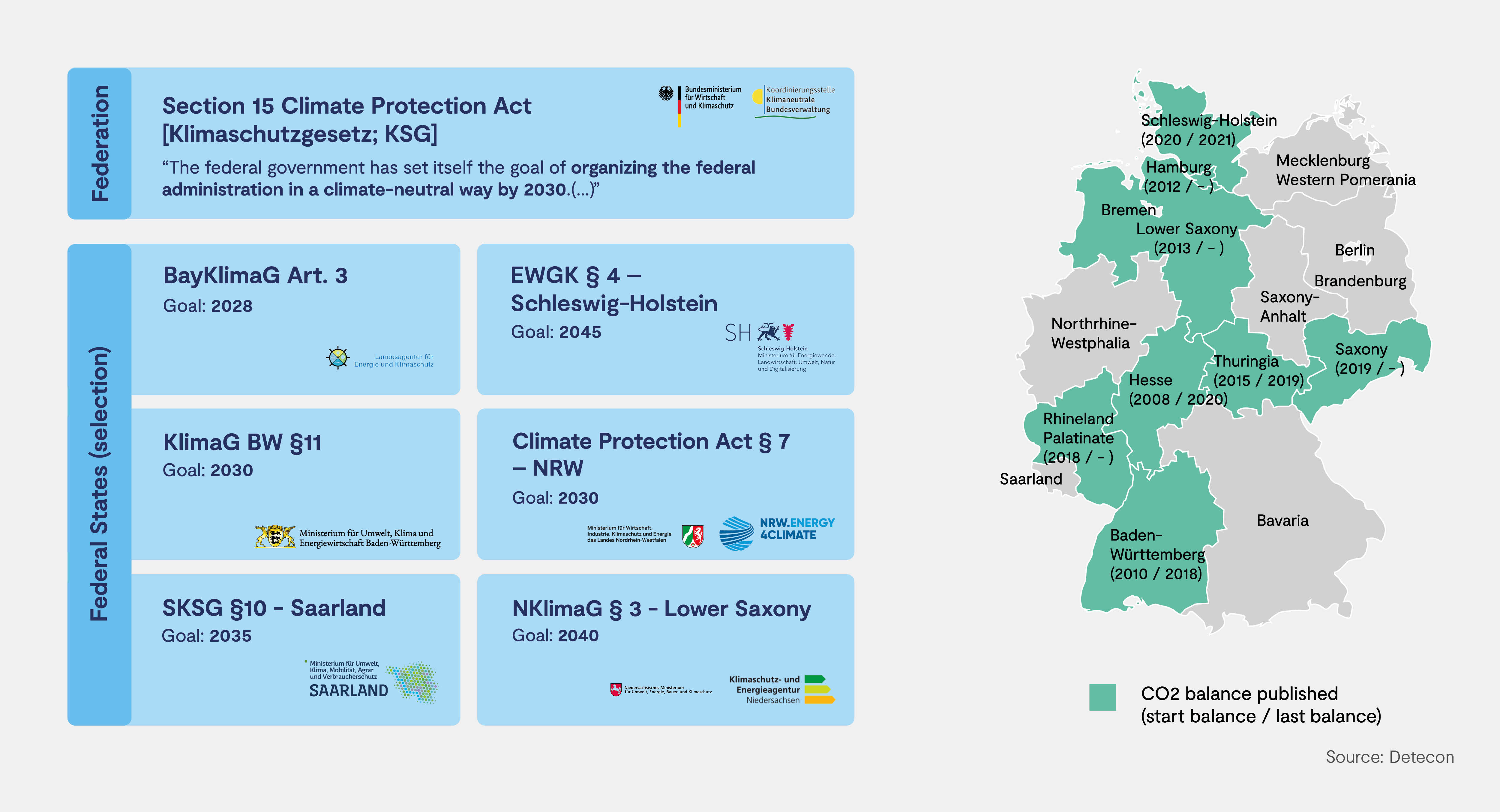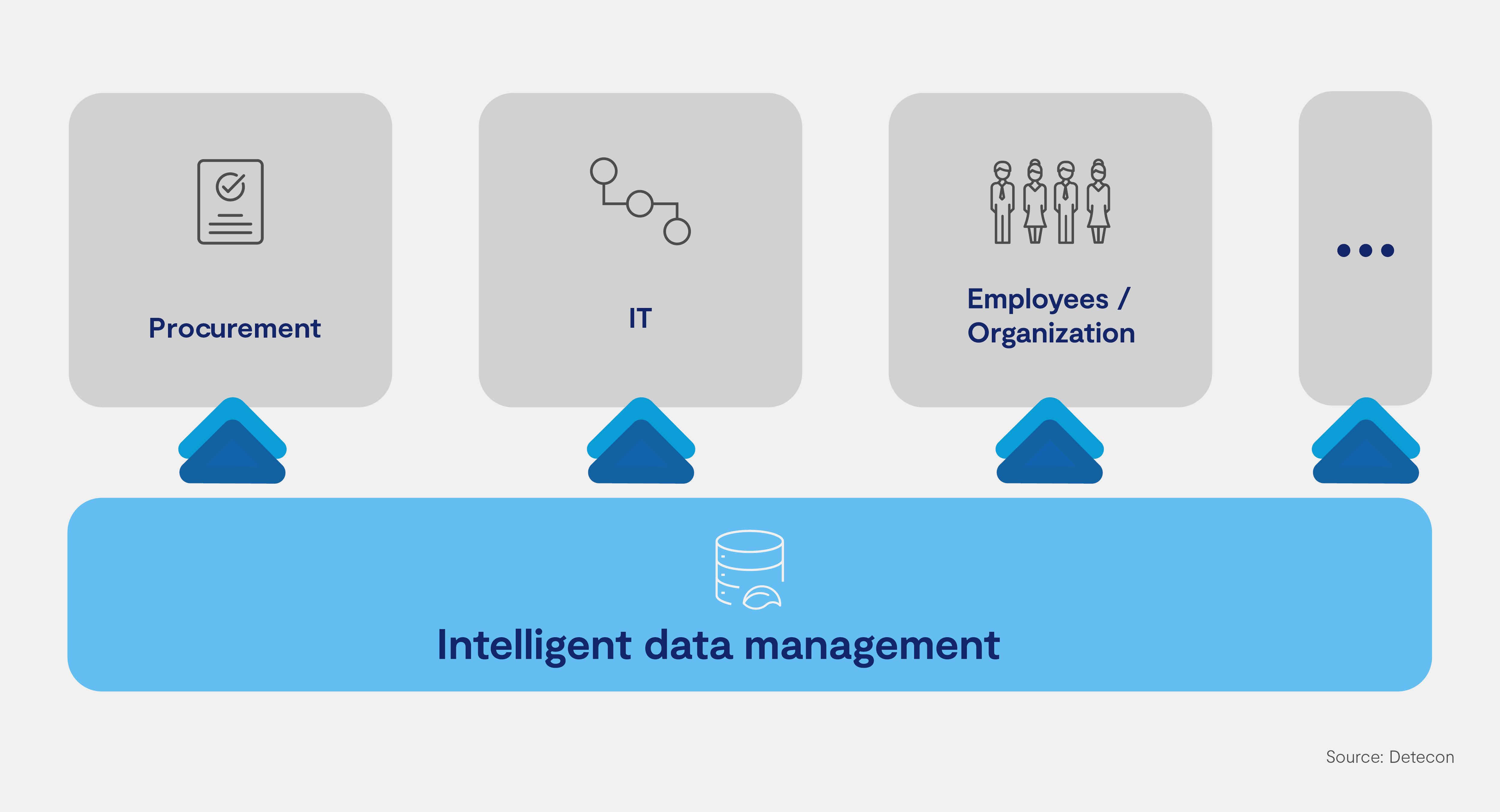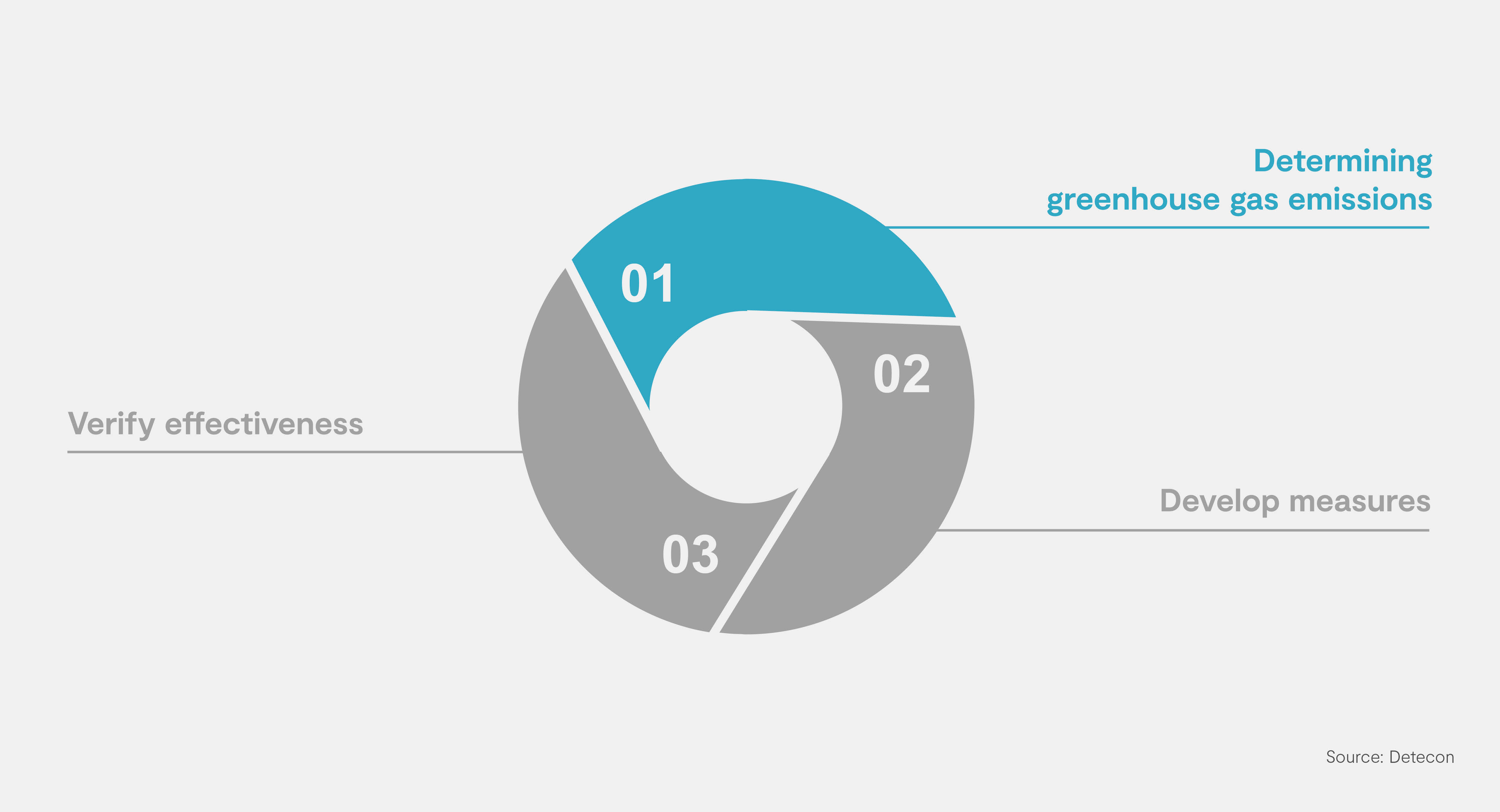Climate change is a global challenge requiring urgent action, especially in public administration. Public administration must develop and implement effective strategies to reduce greenhouse gas (GHG) emissions. The collection, processing, and reporting of standardized sustainability-relevant data represent one of the greatest challenges for the administration. Ministries and public authorities must assume that major investments in their infrastructure will be required in the coming years. With this in mind, the topic of climate-neutral administration must be treated as a top priority in IT, procurement and facility management of administrations. The top management level must actively promote the goal of climate-neutral administration and, in the case of larger government agencies, designate a lead organizational unit to coordinate and steer activities in this direction. (Part 1/2)
Public administration as a role model?
In adopting the Federal Climate Protection Act, the German government has set itself the goal of achieving a climate-neutral federal administration by 2030 (section 15 Climate Protection Act [Klimaschutzgesetz; KSG]). This step assigns to the public sector an important role model function in terms of both compliance with climate protection laws and reduction of its own greenhouse gas emissions. The current Climate Protection Act sets the target date of 2045 for the achievement of climate neutrality in Germany as a whole. Although public administration bears a high level of responsibility in this respect, it is confronted by multiple challenges such as limited resources, slow digitalization and decision-making processes, and public pressure.
7 crucial years
While the federal administration has set itself the goal of becoming climate neutral by 2030, a more heterogeneous picture emerges at the state and local levels. For example, the state of Bavaria aims to achieve the goal of climate-neutral administration by 2028 while the state of Lower Saxony has set itself the deadline of 2040.

At the community level, scheduled targets for local administrations often lag behind state administration targets. The purviews of ministries and public authorities also differ greatly and require different measures for the efficient reduction of greenhouse gases. The significance and challenge of the public sector in reducing greenhouse gases can be seen in the procurement volumes, IT, and employees:
- Procurement: The OECD quantifies the procurement volume of the public sector in Germany at around €500 billion, representing 15 percent of GDP. This underscores the tremendous leverage that the government has in the overall economic transformation toward greater sustainability. The General Administrative Regulation [Allgemeine Verwaltungsvorschrift; AVV] on the Procurement of Climate-Friendly Services (AVV Climate, soon to be replaced by an AVV Environment) for federal procurement transactions includes for the first time life cycle costs and costs of greenhouse gas emissions caused by the activities. Moreover, the current development process for the national circular economy strategy cites public procurement as a key driver of a circular economy featuring the conservation of resources. Sustainability criteria such as energy efficiency and certifications must be given special consideration right from the needs assessment stage.
- IT: IT, particularly data centers, is one of the largest emitters of harmful GHG emissions in public administration. The resolution of the IT Council of 13 September 2022 requires federally owned data centers to meet the criteria of the Blue Angel. Continuous data collection for Blue Angel metrics (e.g., PUE, REF, CUE, etc.) and the implementation of EMAS (Eco-Management and Audit Scheme) and LUMASPlus (property-based environmental management and auditing system) are imperative for GHG reduction and reporting. As of this moment (2022), only one of 184 federal data centers meets the Blue Angel criteria (Federal Maritime and Hydrographic Agency). At the state level, one public IT service provider has reduced its data centers from 6 to 1 (at 2 locations) and now operates one of the most energy-efficient data centers (PUE of 1.25) in Germany. Besides the optimization of absolutely essential on-premises data centers, the more intensive use of cloud service providers is indispensable for consistent decarbonization.
- Employees/organization: According to data from the Federal Statistical Office, the number of employees in the public sector passed the mark of 5 million for the first time in 2021, making it the largest employer in Germany. In the federal administration alone, around 500,000 people work in the (at this time) 16 federal ministries and over 950 federal agencies. Active communication and involvement of employees during the transformation to climate-neutral administration are especially important in large organizations as a means of avoiding internal resistance and misunderstandings. Crucial elements include clear definitions of responsibility, cross-functional networking, and education about the “value” of transformation projects.

“You can’t control what you can’t measure”
Tracking current status and progress is vital in all three areas. Actions can be determined and emissions and costs reduced solely when continuous measurements are available. The ability to measure the effectiveness of initiated activities is of crucial importance in this respect so that evidence-based decisions can be taken in the long term.
Where are the data?
The greatest challenge for many ministries and public agencies is the lack of data availability and data quality. The relevance of comprehensive data use has increased substantially in recent years. Public administration is fully aware of this as is underscored by the updated National Data Strategy 2023. The transformation towards a climate-neutral administration in particular requires a more intensive consideration of the availability and quality of data. One of the questions public agencies need to ask themselves here is whether their data strategy even now takes sustainability-relevant data points into account. What data am I already using today as a basis for emissions reporting? Do I have a clear overview of all available data in my public agency (data catalog)? Are data about my current IT assets and their power consumption/useful life available to me? How are these data collected, secured, and updated? At the federal level, the initiated data laboratories and other facilities can contribute significantly to further development and awareness in the administration.
Clearly, public administration is in need of an effective and transparent approach for the implementation of measures to achieve climate neutrality and for monitoring their effectiveness. Identifying greenhouse gas emissions is the first step in achieving the transformation to a carbon-neutral administration. Here in particular, public administration must increase data collection and quality. In the following chapter, we describe the first step for smart data collection concerning GHG emissions on the path to the achievement of a carbon-neutral administration.

Determining greenhouse gas emissions (Step 1/3)
One of the major problems in recording and balancing CO₂ emissions is data collection. There is a lack of (digital) data, adequate data quality and transparency, and sufficient infrastructure. Furthermore, varying definitions and systems within administrations make it difficult to collect data consistently and effectively.
Example:
Public administration faces the challenge of rendering relevant data usable and finding the right procedure. One example in this sense can be seen in the recording of GHGs emitted by vehicle fleets. As a rule, information such as the kilometers driven and the fuel consumption of single vehicles is already being collected by a fleet manager. The recording is usually done manually or in a separately maintained digital list. If this information is to be used for measurements of carbon neutrality, it must be submitted to a sustainability manager in the administration, who subsequently calculates the CO2 equivalents in another system and ultimately presents a CO2 balance sheet.
Recommendations for action from practice: How the data relevant for the carbon footprint of an administration can be determined
This example illustrates the additional effort required to obtain the relevant data. Owing to the aforementioned challenges in public administration, actions to measure and reduce greenhouse gas emissions are of decisive importance.
Our recommendations for action for systematic data collection and integration:
- Administration, processes, and IT infrastructure: The goal should be the enablement of departments to collect and provide relevant data themselves. Designating a centralized location for data processing can improve data quality.
- Data requirements: Data are the key element for identifying the leading emitters and measuring the effectiveness of actions. The creation of a reliable data basis is dependent on the existence of structures.
- Collection procedure: The creation of the database should be followed by the collection of information according to data and facts. It is important to design the collection procedure so that the results can later be processed in the desired form.
- Integration of the data: Depending on the degree of digitalization and the complexity of the administration, there are various methods for the central processing of the data. The selected method should result in a consistent and comprehensive database.
- Balancing procedure: Knowledge of current CO₂ consumption and its regular updating are required for the development of actions and the measurement of their effectiveness. A balance sheet that illustrates an overall view of CO₂ consumption should be created.
1. balance sheet that illustrates an overall view of CO₂ consumption should be created.
A fundamental recommendation is the orientation to comparable administrations and reliance on previously established procedures. One example is the procedure followed by a state administration that publicly presents the steps of its CO2 balancing method and makes the calculations available as an Excel file to other administrations. The steps involved in calculating total emissions include the identification of the CO2 emission sources, the designation of the organizational units, and the collection of primary data specific to the activities and sources. The recording of emissions within the administration is based on the “factory gate principle.” The primary data of the buildings are exported from various databases or, in the case of leased space, extrapolated by the company itself. The data from the various divisions are collected at a central location where the overall CO2 balance is calculated.
However, the determination of greenhouse gas emissions alone does not achieve the goal of a climate-neutral administration. The knowledge of an agency’s own consumption must lead to the development of effective measures. A public administration should rely on a data-based procedure for this step as well.
In a further article, we will discuss the next phases for achievement of a climate-neutral administration based on data: Derivation of measures and Tracking measures.
Sources:
OECD: Public Procurement in Germany
(DE) Section 15 Climate Protection Act [Klimaschutzgesetz; KSG]
State Administration of North Rhine-Westphalia
(DE) State Office IT.NRW: Employees in the public sector
(DE) German Parliament - Printed Paper 20/3619
(DE) Climate-neutral local governments: A definition of the term
Environment Federal Office: The path to greenhouse gas neutral administration








